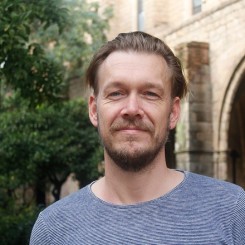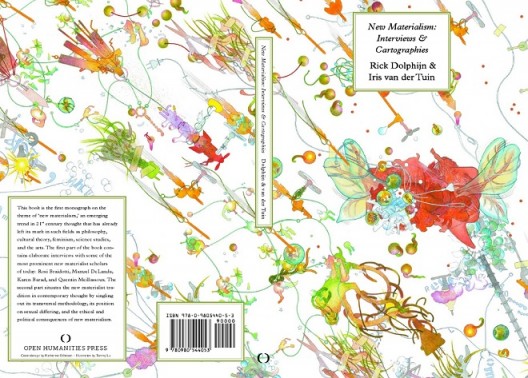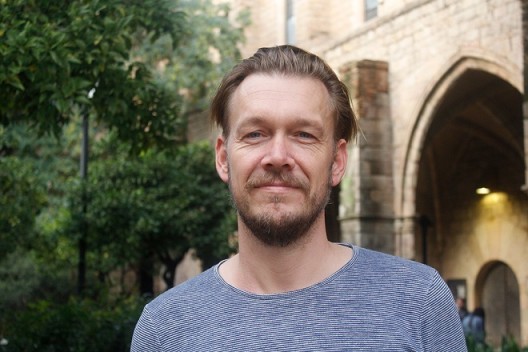What May I Hope For?
“Soils, Séances, Sciences and Politics (SSSP)—Seminar on the Posthuman and New Materialism”, organized by Kristiina Kokstentola and the Institute for Provocation, Beijing (and hosted by the Goethe Institut Beijing), will take place from Sep 30 to Oct 1, 2017. As the media partner, Ran Dian and the Institute for Provocation have collaborated on translating texts from English to Chinese. The below excerpt is the introduction to New Materialism: Interviews & Cartographies.
In academia, revolutionary and radical ideas are actualized through an engagement with scholars and scholarly traditions of the canonized past. Contemporary generations read, or more often reread older texts, resulting in “new” readings that do not fit the dominant reception of these texts. Also, academics tend to draw in scholars from an unforeseen past, those who come from a different academic canon or who have been somewhat forgotten. It is in the resonances between old and new readings and re-readings that a “new metaphysics” might announce itself. A new metaphysics is not restricted to a here and now, nor does it merely project an image of the future for us. It announces what we may call a “new tradition,” which simultaneously gives us a past, a present, and a future. Thus, a new metaphysics does not add something to thought (a series of ideas that wasn’t there, that was left out by others). It rather traverses and thereby rewrites thinking as a whole, leaving nothing untouched, redirecting every possible idea according to its new sense of orientation.
“New materialism” or “neo-materialism” is such a new metaphysics. A plethora of contemporary scholars from heterogeneous backgrounds has, since the late 1990s up until now, been producing (re-)readings that together work towards its actualization. This book is written on the new materialism simultaneously with its fleshing out of the new materialist ambition. The negotiations concerning the new tradition are carried out in the first part of this book. This part consists of four interviews with the most prominent new materialist scholars of today: Rosi Braidotti, Manuel DeLanda, Karen Barad, and Quentin Meillassoux. The second part is made up of four chapters that situate this new tradition in contemporary scholarly thought. The problematics shared by the interviewed scholars are the subject matter of the chapters in Part Two, but it is new materialism that is active everywhere and always throughout. New materialism is the metaphysics that breathes through the entire book, infusing all of its chapters, every statement and argument. New materialism is thus not “built up” in this book: its chapters are not dependent upon one another for understanding their argument. The different chapters of the book can be read independently, although there are many different transversal relations between them.
The interviews in Part One are intra-actions rather than interactions. The former term was introduced by Barad and is central to her new materialism. Qualitatively shifting any atomist metaphysics, intra-action conceptualizes that it is the action between (and not in-between) that matters. In other words, it is not the interviewers or the interviewee or even the oeuvre of the interviewee that deserves our special attention, but it is the sense of orientation that the interview gave rise to (the action itself) that should engender us. For it is in the action itself that new materialism announces itself. We have emphasized this by making strong connections between the individual questions and answers in Part One and the individual chapters of Part Two. This allows the reader to go back and forth between the two parts, in order to gain a deeper understanding of the new materialist tradition
The interview with Rosi Braidotti revolves, firstly, around the issue of the genealogy of new materialism, and around new materialism as genealogical. The latter can be read either as an instance of Jean-François Lyotard’s “rewriting” or of Gilles Deleuze’s “creation of concepts.” The genealogical element of Braidotti’s take on new (feminist) materialism, Braidotti herself being an (un)dutiful daughter of great Continental materialists such as Georges Canguilhem, Michel Foucault and Deleuze (van der Tuin 2009), most certainly pervades the remainder of the book. Braidotti makes clear how it is important to draw situated cartographies of (new) materialisms, and to traverse these maps at the same time in order to produce visionary alternatives, that is, creative alternatives to critique. When it comes to Braidotti’s precise take on the matter of materialism, we encounter a Deleuzean “univocity” or “single matter,” while we simultaneously find Braidotti acknowledging difference as a force of sexual differing on the one hand, and a sexual difference that needs to be traversed in order to come up with post-human, post-anthropocentric, and post-secular visions of sustainability and (intergenerational) justice on the other.
The next interview, with Manuel DeLanda, demonstrates how new materialism is indeed filled with a visionary force, and how an attentive study of a material world asks us to look again at notions such as the mind or subjectivity from which this material world is independent. Braidotti’s genealogy comes back in DeLanda’s formulation of the new materialism, but initially in the form of dynamic morphogenesis as a historical process that is constitutive of the material world. It is only in a secondary instance that DeLanda is interested in the way in which for instance postmodernism or linguisticist idealism has led us away from theorizing scholarly processes as material processes, and as having dynamic, morphogenetic capacities of their own. DeLanda’s univocal methodology is at work from the word go, so it could also be argued that the “new” subjectivity or mind, including significant, not signifying, power differences, is always already implied instead of a priori established.
In the subsequent interview with Karen Barad, this discussion that cuts across the epistemological and the ontological is continued. For the visionary aspect of a new materialism that she calls “agential realism,” Barad brings in a “diffractive” methodology, which is a methodology that allows one to establish the genealogical aspect of Braidotti and the univocity of DeLanda in their entanglement (not interaction). This entanglement comes first, Barad demonstrates via feminist theory and Bohrian quantum physics. She explains how the so-called subject, the so-called instrument, and the so-called object of research are always already entangled, and how measurements are the entanglement of matter and meaning. Barad also singles out the ways in which what she calls “onto-epistemology” is always already ethical, that is, how possibilities for post-human agency are part of what Braidotti would call (sexual) differing, and what DeLanda would call morphogenesis. All of this opens up for a notion of matter that, as Barad says in the interview, affirms that matter “feels, converses, suffers, desires, yearns, and remembers” because “feeling, desiring and experiencing are not singular characteristics or capacities of human consciousness.”
The final interview with Quentin Meillassoux seems to go back to the new materialism proposed by DeLanda. Whereas Barad and Braidotti work towards a new materialism that is immediately ontological, epistemological, and ethical, DeLanda and Meillassoux seem to be more interested in the ontological, either at the expense of an immediate or simultaneous interest in epistemology and ethics (DeLanda) or by leading up to epistemological questions of the classificatory kind (Meillassoux). This reading, however, would itself be classificatory, and would divide the terrain to an extent that may overstate differences and overlook similarities. Meillassoux produces a new materialism (a “speculative materialism”) that radicalizes the relation between epistemology and ontology, thus producing a new materialism that can access the in-itself. Similar to the projects of the three other interviewees, it is especially a subjectivism (also known as a social constructivism, a linguistic idealism, or an identity politics) that is qualitatively shifted in the anti-anthropocentric work of Meillassoux. Here, a “realism” is brought forward that intends to do justice to matter and the contingency of nature most radically, while stressing the limitlessness of thought.
In terms of academic attention, new materialism is in many ways a wave approaching its crest. The amount of publications on this topic is growing, especially in cultural and feminist theory (see e.g. Alaimo and Hekman eds. 2008; Coole and Frost eds. 2010; Bolt and Barrett eds. forthcoming). As the authors of this book we have engaged actively in the constitution and application of new materialism (e.g. Dolphijn 2004; van der Tuin 2008; Dolphijn 2011; van der Tuin 2011). With this book, which is the result of an intense cooperation over several years, we have aimed at producing an open cartography of new materialism that radically explores this new tradition in thought, and that aims at including all that it can virtually do.
1. Alaimo, S and S. Hekman, eds. 2008. Material Feminisms. Bloomington and Indianapolis: Indiana University Press.
2. Coole, D. and S. Frost, eds. (2010). New Materialisms: Ontology, Agency, and Politics. Durham and London: Duke University Press.
3. Bolt, B. and E. Barrett eds.Forthcoming. Carnal Knowledge: Towards a New Materialism Through the Arts. London: IBTauris.
4. Dolphijn, R. 2004. Foodscapes: Towards a Deleuzian Ethics of Consumption. Delft: Eburon.
5. Dolphijn, R. 2011. “‘Man is Ill Because He is Badly Constructed’: Artaud, Klossowski and Deleuze in Search for the Earth Inside.” Deleuze Studies 5(1): 18–34
6. van der Tuin, I. 2008. “Deflationary Logic: Response to Sara Ahmed’s ‘Imaginary Prohibitions: Some Preliminary Remarks on the Founding Gestures of the ‘New Materialism.’” European Journal of Women’s Studies 15(4): 411–6.
7. van der Tuin, I. 2011.“‘A Different Starting Point, a Different Metaphysics’: Reading Bergson and Barad Diffractively.”Hypatia: A Journal of Feminist Philosophy 26(1): 22–42.
Rick Dolphijn is a writer and a philosopher. He teaches and researches at Utrecht University, Faculty of Humanities. From 2017 to 2020 he will be Honorary Associate Professor at Hong Kong University (Hong Kong). He wrote Foodscapes: Towards a Deleuzian Ethics of Consumption (Eburon/University of Chicago Press 2004) and New Materialism: Interviews and Cartographies (Open Humanities Press 2012, with Iris van der Tuin). He has recently published This Deleuzian Century: Art, Activism, Life (edited by Rosi Braidotti, Brill/Rodopi 2014/5). He writes on contemporary, on art, theory and politics. Currently he is finishing a new monograph entitled Cracks of the Contemporary.





